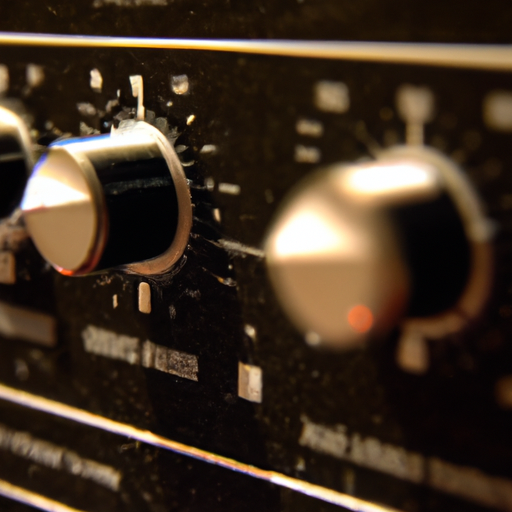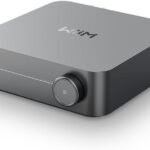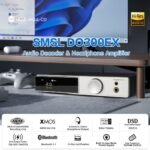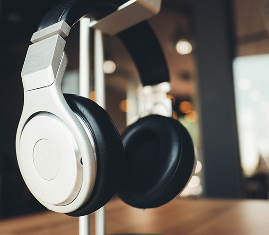If you’re new to audio equipment and wondering what sets a preamp apart from a power amp, you’re in the right place. This article will highlight the distinction between these two crucial components of any audio setup. Whether you’re a passionate audiophile or simply curious about the hobby, understanding the difference between a preamp and a power amp is essential for achieving the best sound quality. So, let’s dive in and explore the nuances of these components to enhance your audio-listening experience.
Understanding the Basics: Audio Amplification
Explanation of audio amplification
Audio amplification refers to increasing the amplitude of an audio signal to make it audible and suitable for playback through speakers or headphones. Amplification is a crucial aspect of audio systems as it ensures the signal is strong enough to drive the speakers and produce sound at the desired volume. With amplification, the audio signal would be more robust to be heard effectively.
Role of amplification in audio systems
Amplification plays a vital role in audio systems, enhancing signal strength and ensuring sound is clear and loud. It allows devices such as CD players, turntables, or microphones to deliver an adequate signal level to the amplifier, which then boosts and amplifies the signal before sending it to the speakers. Strengthening the audio signal enables the reproduction of music or other audio content with fidelity and precision, ensuring that the original intent of the recording is preserved.
Definition of a Preamp
Detailed explanation of a preamp
A preamp, short for a preamplifier, is an essential component in audio systems that serves as the interface between the source equipment and the power amplifier. Its primary function is to amplify and prepare the low-level audio signals from various sources, such as microphones, musical instruments, or line-level devices, for further amplification by the power amplifier. A preamp acts as the intermediary that boosts the weak audio signals before sending them to the power amplifier for further amplification.
Duties and functions of a preamp
A preamp performs several essential duties and functions in an audio system. Firstly, it boosts the low-level audio signals received from different sources, making them strong enough to drive the power amplifier effectively. Secondly, it optimizes impedance matching between the source equipment and the power amplifier, preventing signal degradation or loss. Thirdly, a preamp often includes tone control features, allowing the user to adjust the equalization of the audio signal according to their preferences or to compensate for room acoustics. Lastly, a preamp may provide additional functionalities, such as switching between multiple sources or providing headphone outputs.
Components and Working of a Preamp
The internal components of a preamp
A preamp consists of various internal components that amplify and prepare the audio signals. These components typically include a preamplification stage, tone controls, volume control, input and output connectors, and power supply. The preamplification stage increases the signal level from the source equipment, while the tone controls allow the user to adjust the audio frequency response. The volume control adjusts the output level, allowing the user to set the desired listening volume. Input and output connectors enable the connection of different audio devices, ensuring a seamless integration within the audio system. Lastly, the power supply provides the voltage and current to operate the preamp.
How a preamp works in a sound system
When an audio signal is sent from a source device, such as a microphone or CD player, it enters the preamp through the input connector. The preamp’s preamplification stage then increases the signal level, boosting it to a suitable level for further amplification. The tone controls allow the user to adjust the audio frequency response by boosting or attenuating specific frequencies. The volume control adjusts the overall output level of the preamp, allowing the user to set the desired listening volume. Once the audio signal is amplified and processed by the preamp, it is sent to the power amplifier through the output connector, where further amplification occurs before being played through the speakers.
Pros and Cons of Using a Preamp
Benefits of using a preamp
Using a preamp in an audio system offers several benefits. Firstly, it ensures that low-level audio signals are boosted to an appropriate level, allowing for optimal amplification by the power amplifier. This results in a cleaner, more detailed, and accurate sound reproduction. Secondly, preamps often provide tone control features that allow users to customize the audio frequency response, tailoring the sound to their preferences or compensating for room acoustics. Thirdly, with multiple input connectors, preamps enable easy integration of different audio sources, providing flexibility in system configuration. Lastly, preamps can include additional features such as headphone outputs, making them a versatile tool for personal listening.
Potential drawbacks of using a preamp
While preamps offer numerous advantages, there are also potential drawbacks to consider. One potential drawback is the cost, as high-quality preamps, especially those designed for professional audio applications, can be expensive. Additionally, introducing an extra component in the audio signal chain may add complexity to the system setup and increase the chances of signal degradation or noise. Therefore, choosing a preamp carefully and ensuring compatibility with the existing audio system is essential to avoid potential drawbacks.
Definition of a Power Amp
Detailed explanation of a power amp
A power amp, short for power amplifier, is a component in audio systems responsible for amplifying the audio signals received from the preamp to a level capable of driving the speakers. Unlike a preamp, which focuses on boosting low-level signals, a power amp operates at a higher power level to achieve the desired volume and sound pressure. It takes the audio signals from the preamp and delivers the necessary power to drive the speakers, producing the sound that is heard.
Duties and functions of a power amp
The primary duty of a power amp is to amplify the audio signals to a level capable of driving the speakers, delivering the required power for sound reproduction. It ensures that the audio signals from the preamp are faithfully reproduced, without distortion or clipping, and with enough force to match the specific needs of the speakers. In addition to amplification, power amps may also include protective circuitry to prevent damage to the speakers or the amplifier itself, ensuring reliable and safe operation.
Components and Working of a Power Amp
The internal components of a power amp
A power amp has various internal components that amplify and drive the audio signals. These components typically include multiple amplification stages, input and output connectors, heat sinks, and a power supply. The amplification stages receive the audio signals from the preamp and amplify them to the required power level. Input and output connectors facilitate the connection of the power amp to the preamp and the speakers, respectively. Heat sinks are essential components that dissipate the heat generated during amplification to prevent overheating. The power supply provides the voltage and current to operate the power amp, ensuring stable and reliable performance.
How a power amp works in a sound system
After the preamp has amplified and processed the audio signals, they are sent to the power amp through the input connector. The power amp’s amplification stages then take over, further amplifying the audio signals to a level capable of driving the speakers and producing sound. The amplified signals are sent to the speakers through the output connector, which converts them into sound waves. The power amp’s protective circuitry ensures that the speaker impedance is matched correctly and that the amplifier operates within safe limits, preventing damage.
Pros and Cons of Using a Power Amp
Benefits of using a power amp
Using a power amp in an audio system offers several benefits. Firstly, it provides the power to drive the speakers, ensuring the sound is loud and clear. This is particularly important in large venues or situations requiring high sound pressure. Secondly, power amps are designed to deliver audio signals accurately, without distortion or loss, resulting in a faithful reproduction of the original sound. Lastly, power amps often include protective circuitry, such as short circuit or thermal protection, which safeguards the amplifier and the speakers from potential damage.
Potential drawbacks of using a power amp
While power amps offer numerous advantages, there are potential drawbacks to consider. One potential drawback is their size and weight, as power amps are typically larger and heavier than preamps. This can make them less portable and more challenging to transport or install, especially in mobile or compact audio setups. Additionally, power amps can consume significant power, which may result in higher electricity costs. Therefore, it is crucial to assess the requirements and limitations of the audio system before deciding to incorporate a power amp.
Analyzing the Differences Between a Preamp and Power Amp
Functionality differences
The main functionality difference between a preamp and a power amp is their respective roles within an audio system. A preamp amplifies low-level audio signals and prepares them for further amplification by the power amp. It focuses on boosting weak signals from sources such as microphones or instruments to a suitable level for amplification. On the other hand, a power amp takes the amplified signals from the preamp and delivers the necessary power to drive the speakers, producing the final sound output. While both components involve amplification, they serve distinct purposes in the audio signal chain.
Performance differences
Performance, preamps, and power amps differ in the amplification levels and output. Preamps are designed for low-level signal amplification, ensuring accuracy and fidelity in amplifying weak audio signals. They focus on preserving the original integrity of the movement and providing necessary tonal adjustments. On the other hand, power amps operate at a higher power level, emphasizing output volume and sound pressure to drive the speakers. They are optimized for delivering the necessary power to reproduce sound at high levels without distortion or clipping. The performance differences reflect the tasks each component handles within an audio system.
Cost differences
Cost differences between preamps and power amps can arise due to their different functionalities, performance capabilities, and manufacturing requirements. As preamps typically concentrate on low-level amplification and tonal control, they tend to be smaller and less complex, resulting in lower production costs. Power amps require more robust components and design considerations due to their higher power handling capabilities, making them generally more expensive to manufacture. Additionally, larger size and weight of power amps may increase shipping or installation costs in certain situations. Therefore, the cost difference between preamps and power amps can be influenced by various factors associated with their design and intended use.
Choosing Between a Preamp and a Power Amp
Factors to consider when choosing
Several factors should be considered when deciding between a preamp and a power amp. First, evaluating the specific audio needs and requirements of the intended application is essential. Consider whether the system requires low-level signal amplification, tone control, or high-output power. Secondly, assess the compatibility with existing equipment and the audio system’s overall design. Ensure the selected component integrates seamlessly with other devices and optimizes the system’s performance. Lastly, consider practical factors such as budget constraints, portability requirements, or available physical space, as they can influence decision-making.
How to decide based on your audio needs
To decide between a preamp and a power amp based on your audio needs, you can start by identifying the primary requirements of your audio system. A preamp would be suitable if you primarily amplify low-level audio signals from sources such as microphones or instruments and require tone control capabilities. On the other hand, if your system demands higher power levels and driving the speakers at louder volumes is a priority, a power amp is an appropriate choice. Please look at the specific characteristics of your audio sources, the desired output volume, and any additional functionalities required. You can make an informed decision by aligning your audio needs with the capabilities of preamps and power amps.
Real-life Examples of Preamp and Power Amp Usage
How preamps are used in professional settings
In professional audio settings, preamps ensure optimal audio quality and control. They are commonly used in recording studios, live sound reinforcement, and broadcast environments. In recording studios, preamps amplify low-level signals from microphones, musical instruments, or other recording equipment to a suitable level for further processing or recording. The tonal control capabilities of preamps allow engineers to shape the sound and achieve the desired sonic character during the recording process. In live sound reinforcement, preamps amplify signals from various sources, preparing them for amplification by central power amps and ensuring precise and consistent sound reproduction. Similarly, preamps are used in broadcasting to boost low-level signals from microphones or other audio sources before transmission, guaranteeing optimal signal strength and quality.
Different kinds of power amps are used in concerts and festivals.
Concerts and festivals often require robust sound systems that provide high proper pressure levels to large audiences. Power amps for these applications are designed to deliver significant power output while maintaining audio fidelity. Class D power amps have gained popularity due to their high power efficiency, making them popular in concert and festival settings. These power amps utilize switching amplification technology to convert electrical energy to sound with minimal power loss. They are lightweight, compact, and capable of delivering substantial power output, making them suitable for portable or touring sound systems. Class AB power amps are also commonly used, known for their balanced performance and ability to handle demanding loads while delivering clean and accurate sound.
Everyday uses of preamps and power amps
Apart from professional settings, preamps and power amps are used in various audio setups and applications. In-home audio systems, preamps are often integrated into receivers or audio processors to amplify low-level signals from sources such as CD players, turntables, or media players, ensuring optimal sound quality and tonal control. Power amps drive speakers in home theater systems, allowing for immersive audio experiences. In personal audio setups, portable preamps and headphone amplifiers enhance the audio quality and amplification of music played through headphones or earphones. Additionally, guitar and bass amplifiers utilize preamps and power amps to shape the tone and amplify the instrument signals, enabling musicians to achieve their desired sound.
In conclusion, understanding the basics of audio amplification is essential for anyone interested in sound reproduction. The role of amplification in audio systems must be balanced, and both preamps and power amps play critical roles in this process. While preamps focus on boosting low-level signals and optimizing the audio signal for further amplification, power amps amplify the signals to deliver the necessary power to drive the speakers and produce sound. By analyzing the differences in functionality, performance, and cost and considering individual audio needs, choosing between a preamp and a power amp becomes a more informed decision. Whether in professional settings or everyday applications, the versatile applications of preamps and power amps demonstrate their indispensability in the audio listening hobby.










